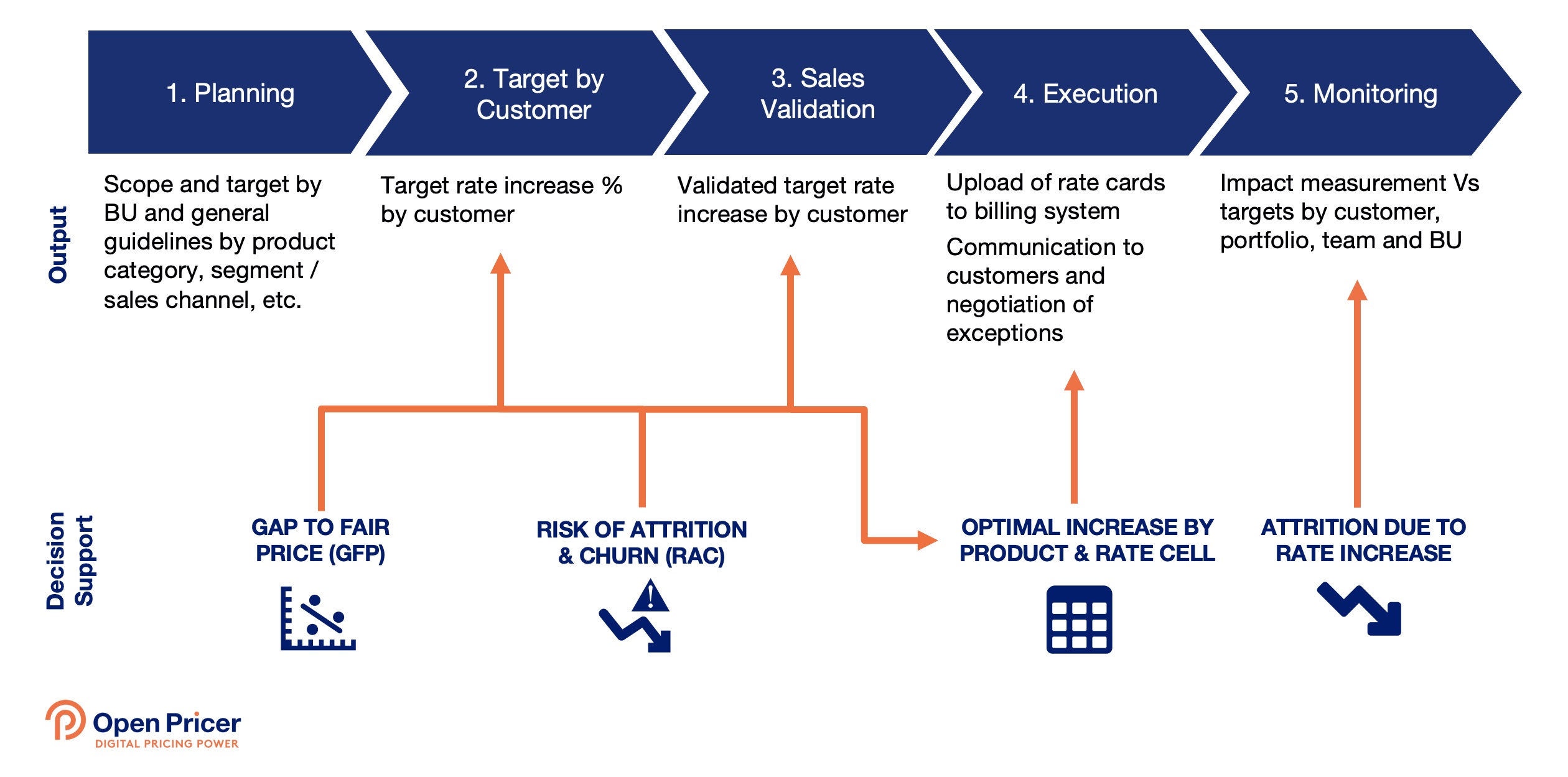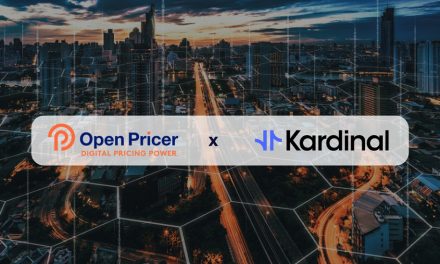
How to improve your next rate increase campaign

Parcel Networks can use the following methodology to get the most out of their general rate increase campaigns (GRI). Indeed, a more precise, systematic, and controlled GRI process can typically generate 0.5 to 1.5 point of additional EBIT every year.
Daniel Rueda, founder and CEO of Open Pricer shares his five steps to success.
The methodology has five steps:
Planning
Targets by customer
Sales validation
Execution
Monitoring
Planning. The first step is to set the financial objectives of the rate increase campaign based on the market context and foreseen evolution of costs. Targets may vary by business unit, product category, customer segment/sales channel. For example, carriers usually set different targets for Domestic, European, and international products and by customer tier (strategic, medium, and small accounts). They can also differentiate the targets by industry to take into account their economic context as a result of Covid-19.
Targets by Customer. The second step is to refine the target rate increase (TRI) by customers. A data driven approach consists in considering the prices paid by similar customers for the same type of service along with the risk of attrition/churn (RAC). For example, a customer benefiting from a lower price than his peers and with very low risk of attrition will receive a higher price increase. Open Pricer’s platform can calculate these metrics and build rate increase recommendations accordingly in coherence with the company strategy.
Sales Validation. At this stage it is necessary to factor in the expected rate of enforcement of target rate increases by sales teams. Sales execs might consider that some targets cannot be achieved due to customer context or even that some customers should be exempted due to contract clauses, operational issues, or competitive context. A lower rate of enforcement requires to increase the average TRI for other customers in order to reach the expected impact of the campaign.
Once the target rate increases by customers are defined, the validation by sales teams can begin. During this phase, each sales executive should be able to request an exception or an exemption for specific customers.
The validation process should be enforced through an e-workflow and monitored to avoid unnecessary erosion (dilution between planned targets and validated targets due to exemptions and exceptions granted by sales teams). Open Pricer’s Rate Increase Campaigns module provides dashboards (global, by BU, by sales team and by sales portfolio) enabling sales execs, sales management, and pricing team to continuously control the validation process. At a given point in time the validated rate increases, the erosion effect and the updated impact of the campaign are displayed to the different stakeholders.
Execution. This step starts with the communication of the price increases to the customers. The communication should be different depending on the segment: a detailed business review meeting for strategic accounts or a written communication of the flat rate increase and/or a link to the new rate card via a customer portal for small accounts. Some customers will accept or not directly react to the rate increase but others will argue and negotiations will take place. It is then crucial to explain the rationale behind the price increases, for instance:
- cost increases (inflation or industry relevant indexes),
- surcharges required by the new context (e.g. peak surcharges due to scarce capacity),
- no rate increase for an extended period of time,
- company investments in product/service improvement,
- the contract did not reach expected profitability/performance due to unexpected changes in customer shipment profile.
These arguments must be backed up by hard data so that account managers can confidently justify the rate increase. Open Pricer Rate Increase Campaigns module enables your sales team to simulate the impact of the new rate cards for each customer’s contract taking into account their actual shipment profile. They can also simulate the impact of a change of shipment profile in case of negotiation of a business extension or cross-selling.
The Contract Dashboard feature enables your sales teams to explore the historical shipment data of your customers, but also to clearly understand the reasons why a given customer is entitled to a higher/lower price increase (e.g. price well below the peers or insufficient quality of service) to guide them in the negotiation.
The Optimal Increase by Product & Rate Cell functionality distributes the planned rate increase for a given customer by products, destination zones and weight bands to minimize the gap to the fair price and correct price inconsistencies. This process consequently reduces the risk of attrition.
An e-workflow similar to the one implemented in the validation step is critical in this step to effectively manage exception requests and limit the erosion effect. A dashboard enables sales teams and managers to control at a given point in time the actual performance at the portfolio, team and global levels. On this basis, rewards and specific compensations can be granted to account managers that achieve their targets to incentivize them.
In terms of process efficiency a key point is the development of an automatic upload of new rate cards to the billing system. This saves a considerable amount of time for sales and finance teams and, above all, eradicates pricing errors.
Monitoring. A measurement of the impact of the price increase campaign on price and volume is essential to assess its success. Two methods can be used to quantify the actual price effect: (a) customer rate cards can be simulated by shipment and compared with the actual invoices; (b) alternatively, a more averaged approach based on comparison of price indexes is possible when customer rate cards cannot be simulated. Then the actual erosion from validated targets can be calculated and reported each month by customer, sales portfolio, sales teams and business units. It is also possible to quantify the impact of the rate increase campaign on volumes (price elasticity). A systematic monitoring of the results of the campaign enables managers to control the process, identify customers with risk of attrition and improve the process overtime.
The Open Pricer platform includes a module that helps parcel carriers to manage and optimize General Rate Increase campaigns (GRI) end-to-end with an impact of 0.5 to 1 point of additional EBIT compared with traditional methods. The features and configuration options of this module are presented in Figure 1.
For more information contact us: www.openpricer.com
Figure 1: General Rate increase process overview

About the author
 Daniel Rueda is founder and CEO of Open Pricer. Open Pricer provides a cloud-based pricing platform that empowers businesses to sell smarter and faster, thus improving their financial performance. Daniel has a strong expertise in Pricing and Revenue Management, starting in 1987 as Revenue Management Project Director at Air France. In 1991, he founded Optims, a leading provider of RMS for the Hospitality, now part of AmadeusGroup. Daniel has helped domestic and international parcel networks to optimise their prices, including: DHL Express, FedEx, TNT Express, La Poste-Colissimo, Chronopost, DPD, Aramex, Estafeta.
Daniel Rueda is founder and CEO of Open Pricer. Open Pricer provides a cloud-based pricing platform that empowers businesses to sell smarter and faster, thus improving their financial performance. Daniel has a strong expertise in Pricing and Revenue Management, starting in 1987 as Revenue Management Project Director at Air France. In 1991, he founded Optims, a leading provider of RMS for the Hospitality, now part of AmadeusGroup. Daniel has helped domestic and international parcel networks to optimise their prices, including: DHL Express, FedEx, TNT Express, La Poste-Colissimo, Chronopost, DPD, Aramex, Estafeta.











